
Horticultural Gallery.

One works to greater or lesser effect in the garden, sometimes to create a "garden scene," other times perhaps to develop a new plant. In this gallery will be shown some new plants I have developed which have some point of interest—though not necessarily of beauty! (Other components of my collection may be found on my Cactus page.) I include as well some pictures of some plants in my garden not developed by me but which I find attractive or interesting. For what they are worth, then:
• The first bloom from my latest Hippeastrum x Sprekelia crop.
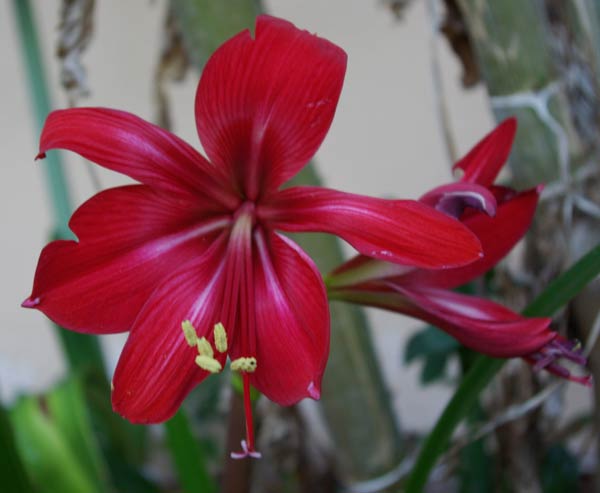
 | This is the first to bloom of about a dozen seedlings
from my last Hippeastrum x Sprekelia cross. All of the seedlings show, in
their leaves, the very varnished glossiness of Sprekelia; the leaf width
varies from seedling to seedling. This first blossom pleases me in showing
good hints of the classic Sprekelia form. I also like the white flashes
on the petals. From crosses between these various siblings, I now have approximately six dozen thriving seedlings from two mothers (I performed a mutual cross). All seedlings have narrow glossy foliage which shows very strongly the influence of the Sprekelia ancestor. My hope is that, once the seedlings start to bloom, some interesting variations will become manifest. |

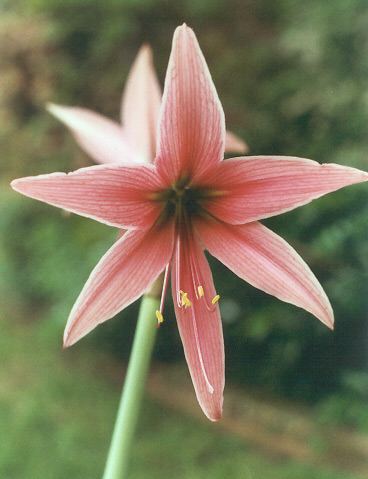
• Another Hippeastrum hybrid.
This is the result of a cross between an old nameless scarlet Amaryllis
(Hippeastrum) which I call 'Pseudojohnsonii' and—most
likely—the
variety 'Sumac Pinini' (better known as 'Spotty'). It shows little or
nothing of the mother variety, and much affinity with the presumed father.
When encountered "in person," it first strikes the observer as being some
sort of exotic coral-colored Lily. This was the first to bloom of about a
dozen seedlings from the same pod; we can look forward to the first bloom
of its various siblings!
• A New Dianthus Cross.
A
cross between the yellow Dianthus knappii and the magenta
Dianthus carthusianorum yielded a crop of seedlings showing much
variation in the flowers, which ranged from near representations of each
parent to divergences in flower coloration, flower size, and petal
serration. In the picture at left, below, the seedling's flower, which
looks very much like one of pure D. knappii at a glance,
nevertheless shows the effect of its father with a slight, barely
discernible, blush on the petals; its sibling, at right, shows a
pronounced blush.


One variation not seen is any
gradation in the yellow or the magenta color of the parents. The yellow,
however much it appears in the blossom, is always the yellow of the
maternal D. knappii, and the magenta, however much it
appears in the blossom, is always the shade of magenta found in the
paternal D. carthusianorum.

• The Collared Belladonna.
This is a seedling which grew spontaneously from seed from a specimen of
the variety 'Johannesburg' of the South African Belladonna, a plant
commonly called "Naked Lady." I call it the "collared" Belladonna because,
importantly, there develops a band at the base of the leaves which—in
contradistinction to the average type—prevents the leaves from
flopping all over their neighbors. The plant's leaves and scape are about
30% shorter than those of the average type (while the blossoms are just as
large); further, the scape is not only more erect in and of itself, but
also—again unlike the common sort with nodding flowers—each
blossom, colored a good strong pink, opens vertically or nearly
vertically, making a more striking visual effect in the garden. Thus, this
Collared Belladonna is neater and much more suitable for garden use in
every way in comparison to the common Naked Ladies. I have given this
Collared Belladonna the name 'Freya', after the Nordic goddess of
Love.
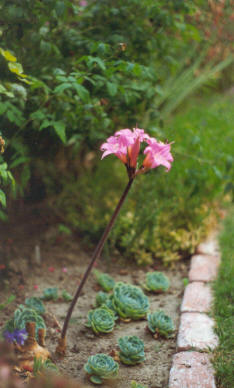
 |
 |
• Tree-Dahlia 'Baldur'.
My new
development of 2014, 'Baldur' adds to the range of Tree-Dahlias by having
flowers which are bi-colored, the full-sized guard petals being
lavender-pink and the smaller inner petals a pure white. Floral form
varies from the outer petals being backswept from the inner group, to
something more closely approaching the look of the standard garden Dahlia.
Occasionally the white portion is reduced to just a white central disk in
the blossom. A very playful variety! Habit and bloom-time of 'Baldur' are
just like those of the common lavender-pink Tree-Dahlias, except perhaps a
little more sturdy.
• A new Amaryllis.
This is a
variety I bred from a cross of Hippeastrum 'Donau' and Sprekelia
formosissima. It shows almost no trace of the Sprekelia, except
perhaps in the slightly more glossy, more yellow-green leaves, which are
also slightly more narrow than those of the typical Hippeastrum
(Amaryllis). Even discounting the complicity of the Sprekelia, however, I
am pleased with the bright and fresh bright rose-pink color, a welcome
relief from the legion of scarlets and salmon-oranges found in Amaryllis
hybrids. As you can see from the full-length picture below, it has a good,
long, graceful stem, further distinguishing it from the stout squat
Amaryllises we see too much of. The Fuchsia in the background is the
Triphylla hybrid 'Koralle'. Update: Sadly, the one characteristic
this plant did acquire from its Sprekelia parent was a great sensitivity
to moisture. After a few years of growing happily and producing offsets,
one by one all specimens rotted away, even those in the most porous soil
mix. Alas!
 |
 |
• A new Bourbon
Rose.
This (below) is 'Charles XII', new Bourbon rose I raised
from seed of the Bourbon 'Souvenir de Victor Landeau' (Moreau-Robert,
1890). It is extremely vigorous, forming long strong canes perfect for
training against a fence. The blossoms come both singly and in paucifloral
clusters, and have a rich, moderate fragrance. The plant is healthy and
strong, and, once mature, is rarely without a blossom; at the height of
the season, the plant is truly wreathed in bloom. Several online rose
nurseries have it available for purchase. It is named after the ambitious
Swedish king who lived 1682-1718. A sibling of it, 'Gustavus Vasa',
different in many ways but also attractive, has not yet been
propagated.

• The Case of the Anomalous
Habranthus.
 |  |
From a seed of a completely typical
Habranthus robustus came this individual with markedly larger
flowers with twisted petals. It passes on these characteristics to its
seedlings. An interesting development! In the pictures, I include a
blossom of a typical Habranthus robustus for comparison. While
appearing extremely similar to the cultivar 'Russell Manning', reputedly
an interspecific cross, this plant is most certainly not a cross.
I suspect that 'Russell Manning', like my anomalous Habranthus, instead
represents a spontaneous variation which occurs rarely within the context
of the pure species.
• Iris 'Amas'.
This old Iris,
found to be tetraploid, was collected in Amasia, northern Asia Minor, by
Foster in 1885. The foliage is a pleasant glaucous green, which sorts well
with the blue and bluish-violet blossoms. The characteristic floppiness of
the standards gives the flower a casual, amiable air. To my eye, this Iris
shows a strong affinity with Iris pallida dalmatica, which latter
is however more lavender, taller, standards more strongly erect, and
flowers with a degree of fragrance lacking in 'Amas'.
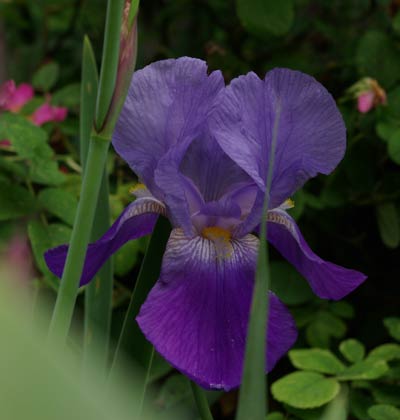

• 'Cross Your Fingers'.
This
unusual plant with the leaves having a double tip in which the twin
extremities cross, is a seedling of Amaryllis belladonna
'Johannesburg'. Again, as with the pink Amaryllis above, it is possible
that Sprekelia is the pollen parent. The story is that, having emasculated
and isolated several blossoms of 'Johannesburg', I pollinated them with
Sprekelia pollen. For all but one of the resulting seed pods, the seeds
withered at an early stage of development; for the remaining pod, an
extremely large number of seeds resulted. Supposing this to mean that the
blossom had been contaminated with 'Johannesburg' pollen somehow, in
chagrin I tossed the seeds into a remote corner of the garden which was
devoted to roses and forgot about them until, a year later, I happened to
notice that one of the seedlings which sprouted had leaves with a double
tip and a somewhat channeled surface, unlike the mono-tip-ical, smooth
leaves of the normal Belladonna. I felt that this was probably only a
temporary condition which would disappear over the ensuing dormant period;
but I kept an eye on this seedling, as well as on another odd one nearby
which had the channeled leaves as well, but without the double tip. The
next season, to my surprise and delight, the plant returned manifesting
the same anomaly. It has not bloomed yet; but it is a stronger plant than
its more normal-looking siblings, the leaves of one or two of which can
also be seen in the picture (the fallen petals which may be seen are from
the rose 'Ramona', a Lævigata hybrid). Update: 'Cross Your
Fingers' went dormant one year, never to return.
• Son of the Archduke.
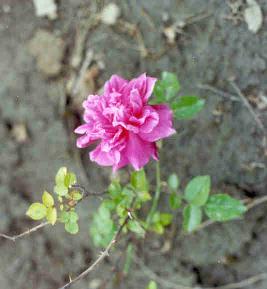
This fine fellow is a seedling of the popular
China Rose 'Archiduc Charles' (Laffay, circa 1825) which I raised a few
years ago. The seedling was very strong in its first six months, then
lapsed into a lassitude which lasted for about two years. The plant
however has now gained some slight vigor and health, though remaining
small enough to be covered by a large mixing bowl! The blossoms are
variable, though in a different way from the variability of its parent
variety, the color ranging from an intense pink through rose-pink,
raspberry red, ruby, and deep crimson, depending upon conditions; and I
much like the informal form, which is rather like that of the Sasanqua
Camellia 'Showa-no-Sakae'. I will not be propagating the plant until it
grows large enough to look as if it will sustain the loss of some of its
twigs without suffering! Update: The plant refused to bloom
further, and I terminated its existence.
 |  |
• Lycoryllis!
This
flower—which looks rather too much like a typical Amaryllis
belladonna variety for this hybridist's comfort!—is actually
from seed of Lycoris aurea—or what was sold as Lycoris
aurea about 1980—following a pollination of the Lycoris with
pollen indeed from Amaryllis belladonna. The plant waited some
fifteen years before blooming for the first time; shown is its first
bud. The plant shows very little of its mother's influence. The scape
and subfloral spathulate bracts are tinged purple, as in the Belladonna.
The main color is obviously that of the Belladonna. However, the
proportions of the scape are more slender than either parent. The
exterior of the flower has large brush-marks of snowy white, which show
up well in the garden; the inside has as well a large white zone
"brushing" a bit farther out on the tepals than is normal for
Belladonnas. The very first blossom had only 5 tepals; later blossoms
had 6 like both parents. This is no great advance in the field of
Horticulture—one could have wished that there had been more of a
maternal influence—but it is of a certain amount of interest due to
its parentage. It being a mediocrity, and refusing to serve as a parent,
I have rendered it extinct.
UPDATE, November 2016: I have
been able to repeat this cross successfully, this time with a dwarf
Belladonna as the male parent. Numerous seeds have ripened on Lycoris
scapes from two separate specimens (one of them the very one which was
the female parent on the previous cross). At the same time, I attempted
the reciprocal cross, with no seeds resulting on the Belladonnas. It now
is clear, the experiment have been repeated successfully, that
Lycoris can be successfully fertilized with Amaryllis
pollen (though not vice-versa).
 |
 |
• A Variegated-Leafed Hippeastrum.
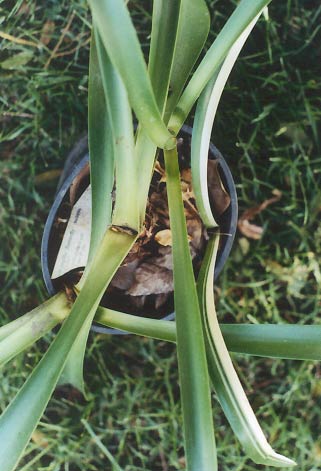
This Hippeastrum papilio with variegated leaves occurred spontaneously as an offset of a regular H. papilio which I have. Seen here still attached to its mother-plant, it has maintained its variegation for several years now.
• Sweet William.

The patterns found in individual blossoms of Sweet Williams are often fascinating. This individual is from the widely varying crop I grew representing the third generation in my garden of Sweet Williams of the "Summer Sundae" strain, which, unlike many Sweet Williams strains, grows and blooms well here in Southern California.

• The garden is protected against would-be malefactors by the loyal spirit of this earnest and sharp-eyed professional.